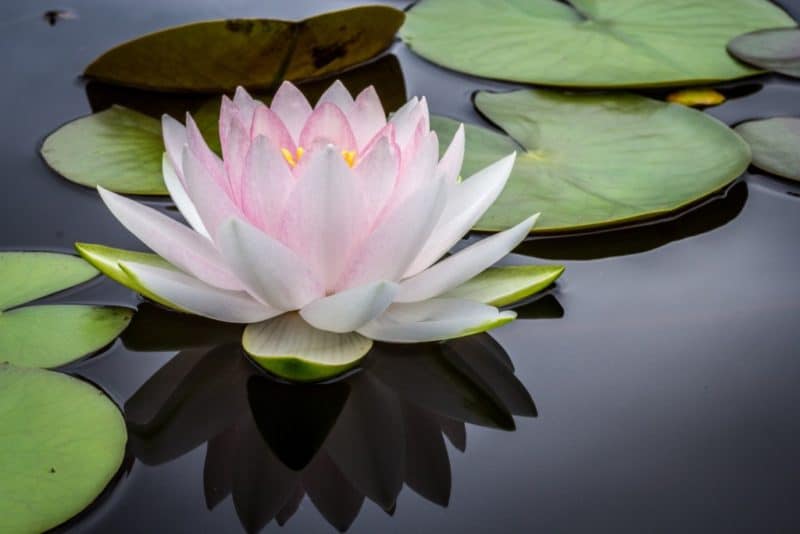You’ve been looking at a particularly beautiful water lily, but are worried that you won’t be able to grow it inside with the tap water you already have.
On their own, pond plants will be fine if left in tap water, especially when grown inside. However, if you want to add any fish or create a diverse ecosystem outdoors, you will want to avoid using tap water as it can be dangerous to fish and their ecosystems due to the higher levels of chlorine.
There are ways to grow pond plants indoors, and also make your tap water safe for outdoor ponds. Read on for more information.
Growing Aquatic Plants Inside
If you’re planning on growing aquatic plants inside, be sure to choose a container with a wider mouth, which will make it easier to work with.
If choosing a plant that require soil or gravel (also known as “substrate”) for their roots at the bottom, be sure to avoid getting regular potting soil by getting specialized aquarium blends. Regular potting soil can be quite messy and float around.
For your rooted plant, in your chosen container, add an even layer of about 2 to 3cm of your potting mix. After having done this, you will add your plants, making sure to anchor them in the soil. Once you have your plants rooted, add a layer of gravel. This layer doesn’t need to be as deep as the first layer. This will help prevent the soil beneath from being disturbed.
When adding the water to your chosen container, if your plants are “rooted,” be sure to fill slowly so as to not disturb the roots or soil layers.
Put your plant somewhere where they will get plenty of light, but not in a place where it will get direct light. Direct light encourages algae growth. To help encourage plant growth, use LED grow lights.
Your water will need to be refilled from time to time due to evaporation. When replacing the water, don’t replace all of it at once. This also reduces the chances of algae growth. If your container is large enough, you can also add a pond snail to keep the glass clean of algae and fertilize the plants with their manure.
If you are finding that the water is emitting odd smells, use pieces of activated charcoal. Not only will this help elminate bad smells, it can also help make the water more clear.
Tap Water in Fish Ponds
Tap water often contains chlorine in order to kill bacteria and viruses. While this is a good thing for drinking water, in ponds this chlorine will kill off the bacteria necessary to convert fish waste from ammonia to a less toxic nitrate.
Not only will the chlorine kill of important bacterias, but it can also kill your fish very quickly by damaging their gills, scales, and burning them from the inside out.
Water companies also frequently use chloramine to disinfect our drinking water, which is even more deadly for fish because it is a mixture of both chlorine and ammonia.
Because tap water also has higher levels of nitrates than other water, it can encourage plants like duckweed and blanket weed to grow across the surface of the pond. If left to continue growing, it can take over, which would decrease the oxygen levels and prevent light from reaching the bottom of a pond. This may kill off fish and other aquatic plants in the pond.
If you find that you have a duckweed problem, check to make sure there isn’t an excess of leaves at the bottom of your pond. These leaves can also provide the nutrients needed for the weed to thrive. Using a pool net, you can scoop out the duckweed from the water. While this won’t completely stop the growth of duckweed, repeatedly removing it and keeping your pond clean should keep it under control.
Making Tap Water Safe for Ponds
Before you can make your water safe to put in your pond, you need to find out how your water is being sanitized because the way you remove chlorine from your water is different from how you would remove chloramine from your water. You can find out what is being used to treat your water by contacting your water company.
You can also purchase ammonia detection kits and chlorine detection kits to test your water yourself. If there is any ammonia in your water, chances are that it is treated with chloramine. Your pond water should have absolutely no chlorine or chloramine in it if at all possible. The highest level it should be at is 0.01 parts per million, however the lower you get the better.
If your water was treated with chlorine, one way to purify your water is to let the water stand for about two day so the chlorine can evaporate into the air. This will not work for chloramine as chloramine does not evaporate into the atmosphere.
Some universal ways to treat your tap water for chlorine and chloramine are a dechlorinator or an activated carbon charcoal filter. Dechlorinators are basically filters specifically used to remove chlorine and chloramine from water. Activated carbon charcoal filters do the same, while also filtering out other things like pesticides and pollutants, among other things.
One of the most common ways to treat tap water is with a water conditioner. Each water conditioner is made slightly different and so you will want to carefully read about each to determine which is the right one for you.
For all of these options, you will want to treat your water before pumping it into your pond. Once you have treated the water and determined that the pH levels are where they should be at, be sure the water is the same temperature as the pond you will be pumping it into. Make sure to pump it in slowly so as to not shock your fish or plants from the rush of water.
